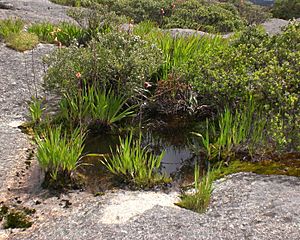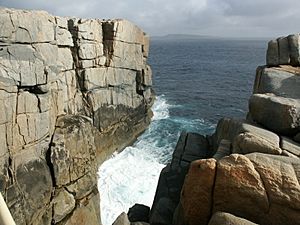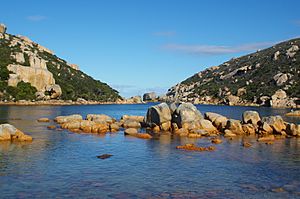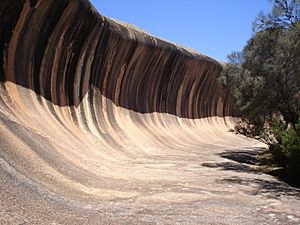Granite outcrops of Western Australia facts for kids

Granite outcrops of Western Australia are amazing natural rock formations found all over Western Australia. They are mostly made of a strong rock called granite. You can see different types of these outcrops, like big dome-shaped rocks called bornhardts, or tall, isolated hills known as inselbergs. Some look like piles of rocks (castle koppies) or smaller rounded hills (Nubbins). These outcrops rise suddenly from the flat land around them. They create many different small living spaces, called microhabitats, for plants. They also offer food and safe places for animals throughout the year. Because of this, these areas have a lot of different living things, known as biodiversity, and many unique species found nowhere else. They are also very important to the Aboriginal people and the European history of Western Australia.
Contents
The Amazing Ecology of Granite Outcrops
Granite outcrops are like special islands for nature. They often provide homes for very old types of plants and animals that remind us of a time when the climate was wetter.
Life on the Rock Surface
The smooth rock surfaces are covered in a thin layer called a biofilm. This film is made of tiny living things called cyanobacteria, which give the rocks their unique colors. You can also see crusts of lichens, which are a mix of algae and fungi. These lichen mats can be incredibly old, sometimes even a billion years old! When there's enough moisture, mats of moss and spike-moss also grow. These green mats then create opportunities for other small creatures to live there.
Plants and Their Special Homes
At least 1300 different kinds of plants grow on granite outcrops in Western Australia. Many of these plants are found only on these rocks. Some plants grow in cracks and splits in the rock face. Trees or large shrubs might even grow in a special small shape, like a natural bonsai. Large pieces of rock that have split off or cracked create cool, damp, and safe spots. These narrow spaces are perfect for plants and animals that have adapted to live in such unique conditions.
Gnamma Pools: Water for Life
Rainwater often collects in natural pools on the granite outcrops. These pools are called gnammas. They are home to about 230 types of tiny water creatures, called aquatic invertebrates. At least 50 of these are found only in these gnamma pools! These pools also provide fresh water for other animals that live on or visit the outcrops.
Unique Plant Species
The plants on these granite outcrops are truly special. You can find tall trees like eucalypts, sheoaks, acacias, and rock figs. Smaller plants include species from the verticordia, banksia, grevillea, and melaleuca families. There are 141 different types of orchids that grow on these outcrops. A surprising 16% of these orchids are found only on these rock formations. Some orchids, like Spiculaea ciliata, might only be found in a few locations, just a few kilometers apart.
Animals of the Outcrops
Many animals live only on granite outcrops. These include four types of reptiles, a special kind of spider called Teyl luculentus, and the young (larvae) of a fly called Archaeochlus. The outcrops are also important homes for rock-wallabies, like the black-flanked rock-wallaby, and the ornate crevice-dragon, Ctenophorus ornatus. These rocky areas also offer safe places for animals to hide from predators or to find shelter from very hot or cold weather.
Granite Outcrops in the Great Southern Region
Along the southern coast of Western Australia, granite outcrops face strong winds and the powerful waves of the ocean. They often form steep coastlines, headlands (rocky points sticking out into the sea), and islands.
- The granite formations at the coast of Torndirrup National Park
- Gibraltar Rock
- Castle Rock and Balancing Rock at Porongurup National Park
- The granite formations at Two Peoples Bay
- The granite formations at Waychinicup National Park, Mount Manypeaks and Cheynes Beach.
- Elephant Rocks, granite boulders that make up Greens Pool and other forms at William Bay National Park
- The granite formations around Mount Melville and Mount Clarence in Albany
Granite Outcrops in the Wheatbelt Region
- Baladjie Rock
- Beringbooding Rock
- Boyagin Rock
- Bruce Rock
- Corrigin Rock
- Datjoin Rock
- Eaglestone Hill
- Elachbutting Rock
- Gorge Rock 32°27′S 118°00′E / 32.450°S 118.000°E
- Hunts Soak
- Jilakin Rock 32°40′S 118°19′E / 32.667°S 118.317°E
- King Rock
- Kokerbin Rock also known as Kokerbin Hill 31°53′S 117°42′E / 31.883°S 117.700°E
- Wave Wall, Dog Rock, Devils Marbles
- Mount Walker 32°01′S 118°45′E / 32.017°S 118.750°E
- Anderson Reserve, Twine Reserve and Roe Dam
- Puntapin Rock
- Sandford Rocks
- The Humps
- Wave Rock
- Westonia Common
- Boodalim Soak
- Yeerakine Rock
- Yilliminning Rock east of Narrogin
- Yorkrakine Rock






